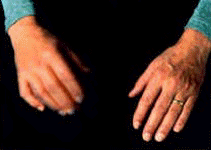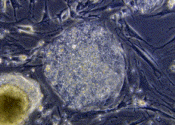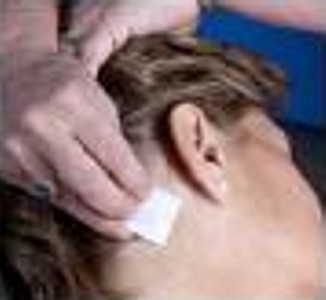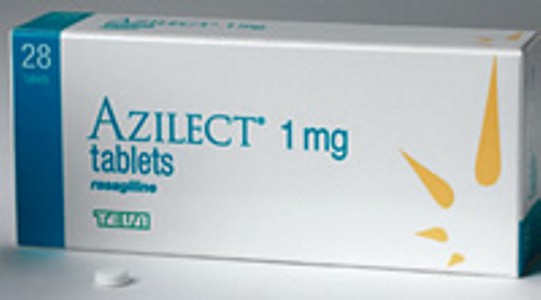24th October 2008 - New research
tremor only PARKINSON'S DISEASE
Acta Neurologica Belgica [2008] 108 (2) :
48-52 (Leventoglu A, Baysal AI.)
Complete abstract
Although tremor is often considered to be a characteristic symptom of
Parkinson's Disease, about 30% of people who have Parkinson's Disease
don't have tremor. However, there are some people with Parkinson's Disease
whose symptoms are virtually only tremor. Researchers analysed what happened to
people whose first symptoms were tremor, in order to see if they
eventually developed other symptoms of Parkinson's Disease, such as
rigidity and bradykinesia (slowing of movement).
 Even amongst those people with only tremor there were found to be
different
types
: those with rest tremor, mainly in the upper limbs; those with rest
tremor only in a lower limb; and those with
only jaw tremor. Some patients with pure Parkinsonian
tremor were found to be without bradykinesia or rigidity for a long time.
This means that instead of the typical (and false view) of Parkinson's
Disease including tremor, rigidity and bradykinesia (slowing of movement),
that there were those at one extreme with only tremor, and those at the
other extreme who have no tremor at all. There is therefore clearly no
characteristic set of symptoms that define Parkinson's Disease.
Even amongst those people with only tremor there were found to be
different
types
: those with rest tremor, mainly in the upper limbs; those with rest
tremor only in a lower limb; and those with
only jaw tremor. Some patients with pure Parkinsonian
tremor were found to be without bradykinesia or rigidity for a long time.
This means that instead of the typical (and false view) of Parkinson's
Disease including tremor, rigidity and bradykinesia (slowing of movement),
that there were those at one extreme with only tremor, and those at the
other extreme who have no tremor at all. There is therefore clearly no
characteristic set of symptoms that define Parkinson's Disease.
�
17th October 2008 - New review
implanted neurons DEVELOP PARKINSON'S DISEASE
This review details how new cells put in to
the brain to rid Parkinson's Disease develop the signs of Parkinson's
Disease themselves. The Neuropathological changes in Parkinson's disease
usually progress slowly and spread
according to a characteristic pattern. Recent papers have shed light on
this progression of pathology by examining the
fate of neurons grafted into the brains of patients with Parkinson's
Disease.
 Two of these studies demonstrate that new healthy neurons grafted
in to the brains of people with Parkinson's Disease gradually develop the
same pathology as the existing neurons. According to these studies,
implanted neurons developed biochemical symptoms of Parkinson's Disease
after transplantation : alpha-synuclein- and ubiquitin-positive Lewy
bodies. It is inevitable that any new cells will eventually function at
the same insufficient rate as the existing cells, because their
biochemical environment would be identical.
Two of these studies demonstrate that new healthy neurons grafted
in to the brains of people with Parkinson's Disease gradually develop the
same pathology as the existing neurons. According to these studies,
implanted neurons developed biochemical symptoms of Parkinson's Disease
after transplantation : alpha-synuclein- and ubiquitin-positive Lewy
bodies. It is inevitable that any new cells will eventually function at
the same insufficient rate as the existing cells, because their
biochemical environment would be identical.
�
15th October 2008 - New research
vitamin d deficiency in parkinson's disease
Archives of Neurology [2008] 65 (10) :
1348-1352 (Evatt ML, Delong MR, Khazai N, Rosen A, Triche S, Tangpricha
V.)
Complete abstract
Researchers compared the prevalence of vitamin D deficiency in patients
with Parkinson's Disease with age-matched healthy controls and patients
with Alzheimer disease. Significantly more patients with Parkinson's
Disease (55% of them) had insufficient vitamin D, in comparison to 36%
healthy controls, and 41% in people with Alzheimer's Disease. The
researchers claim that this data supports a possible role of vitamin D
insufficiency in Parkinson's Disease. They suggest that further studies
are needed to determine the factors contributing to these differences and
elucidate the potential role of vitamin D in
the cause and clinical course of Parkinson's Disease. However, Vitamin
D has no role at all in the formation of
dopamine, the substance whose deficiency causes Parkinson's Disease. For
more
information go to the
Biochemistry of Parkinson's Disease.
 Also, in severe cases of Vitamin
D deficiency, there
is no known relationship with Parkinson's
Disease as there would be if Vitamin D deficiency could cause it. The
primary role of Vitamin D is in the formation and structure of bone.
Sunlight is a known source of Vitamin D. So the link between Vitamin D and
Parkinson's Disease may be due to those people with Parkinson's Disease
who have mobility problems being exposed to less sunlight. Although
sunlight and certain foods are sources of Vitamin D, they are usually
insufficient sources. However, vitamin supplements usually supply 50%-100%
of a person's needs.
Also, in severe cases of Vitamin
D deficiency, there
is no known relationship with Parkinson's
Disease as there would be if Vitamin D deficiency could cause it. The
primary role of Vitamin D is in the formation and structure of bone.
Sunlight is a known source of Vitamin D. So the link between Vitamin D and
Parkinson's Disease may be due to those people with Parkinson's Disease
who have mobility problems being exposed to less sunlight. Although
sunlight and certain foods are sources of Vitamin D, they are usually
insufficient sources. However, vitamin supplements usually supply 50%-100%
of a person's needs.
�
13th October 2008 - New clinical trial
Nexalin device clinical trial
The Michael J.Fox Foundation is to carry out
a clinical trial using the Nexalin Device. For more information go to
The Michael J.Fox Foundation. Nexalin Therapy is a technology that
uses a mild stimulation of the brain to treat a variety of mood disorders,
specifically Anxiety, Depression, and Insomnia.
 The waveform of Nexalin is administered by placing medical grade conductive pads produced
specifically for the Nexalin device on the forehead and behind
each
ear, which are connected to the Nexalin device with thin cables. The
patient is placed in a reclining chair for the duration of a treatment
session, which typically lasts for approximately forty minutes. For more
information go to
Nexalin Advanced Therapy.
The disorders usually treated share a similar
biochemistry with Parkinson's Disease. The intended effect appears to be
like a milder version of DBS (Deep Brain Stimulation) but without using
surgery as DBS does. In January 2008, a number of Parkinson's Disease
patients carried out their own informal study. For more information go to
ParkinsonsRebels.
The waveform of Nexalin is administered by placing medical grade conductive pads produced
specifically for the Nexalin device on the forehead and behind
each
ear, which are connected to the Nexalin device with thin cables. The
patient is placed in a reclining chair for the duration of a treatment
session, which typically lasts for approximately forty minutes. For more
information go to
Nexalin Advanced Therapy.
The disorders usually treated share a similar
biochemistry with Parkinson's Disease. The intended effect appears to be
like a milder version of DBS (Deep Brain Stimulation) but without using
surgery as DBS does. In January 2008, a number of Parkinson's Disease
patients carried out their own informal study. For more information go to
ParkinsonsRebels.
�
8th October 2008 - New research
THE EFFECT OF RASAGILINE ON PARKINSON'S
DISEASE
Fortschritte der Neurologie Psychiatrie [2008] 76 (10) : 594-599 (Jost WH,
Klasser M, Reichmann H.)
Complete abstract
Rasagiline (Azilect) is a is a MAO-B inhibitor that is sometimes used for
the treatment of Parkinson's Disease on its own, or by people who are
taking L-dopa, who are having end of dose fluctuations. This large study
gave special attention to the effect of Rasagiline on the patients'
quality of life. Different aspects of quality of life were rated by the
patients using the self-rating Parkinson's Disease Questionaire (PDQ-39)
and the Columbia University Rating Scale (CURS). In addition, patients
documented the number of hours spend in the OFF-state. Rasagiline was
found to be most used alongside L-dopa (in 82% of people taking it), and
then by people taking dopamine agonists (in
66%
of cases). The symptom score was reduced by 22% using Rasagiline.
 The
proportion of patients with OFF-periods, which is the main purpose of its
use, reduced from 66% to 49%. Time spent in the OFF period was also
reduced from an average of 2 hours to 45 minutes. Quality of Life improved
by 15%. Rasagiline was found to give better effects than Selegiline in
every respect. Besides the side effects that it causes, Rasagiline will
eventually lead to an opposite effect due to a biochemical process called
"feedback inhibition". This is a means the body uses to counteract
anything artifical imposed on it.
The
proportion of patients with OFF-periods, which is the main purpose of its
use, reduced from 66% to 49%. Time spent in the OFF period was also
reduced from an average of 2 hours to 45 minutes. Quality of Life improved
by 15%. Rasagiline was found to give better effects than Selegiline in
every respect. Besides the side effects that it causes, Rasagiline will
eventually lead to an opposite effect due to a biochemical process called
"feedback inhibition". This is a means the body uses to counteract
anything artifical imposed on it.
�
3rd October 2008 - New review
PARAQUAT AS A CAUSE OF PARKINSON'S DISEASE
Paraquat is the trade name for N,N'-Dimethyl-4,4'-bipyridinium dichloride,
a quaternary ammonium herbicide. Other members of this class include
diquat, cyperquat, diethamquat, difenzoquat and morfamquat. The compound
is widely used as a quick-acting, non-selective herbicide. It kills green
plant tissue on contact and is redistributed within the plant but does not
harm mature bark. Paraquat was first produced for commercial purposes in
1961 by ICI (now Zeneca) and is today among the most commonly used
herbicides. Pesticides are known to be associated with an increased rate
of Parkinson's Disease [1].
 Common
means : Paraquat is used as a herbicide. There is a greatly increased
likelihood of developing symptoms by people involved in horticulture and
agriculture [2]. Pesticides are also known to affect well water [3].
Common
means : Paraquat is used as a herbicide. There is a greatly increased
likelihood of developing symptoms by people involved in horticulture and
agriculture [2]. Pesticides are also known to affect well water [3].
Means of toxicity : Paraquat structurally resembles MPTP and its
metabolite MPP+. MPTP and MPP+ are neurotoxic chemicals, that induce
Parkinson's Disease in exposed humans. Paraquat might therefore might, as
do MPTP and MPP+ inhibit tyrosine hydroxylation, which is essential for
the formation of dopamine.
Symptoms : Paraquat is known to kill dopaminergic neurons in mice [4, 5],
and is associated with the symptoms of Parkinson's Disease in humans [6].
However, it is claimed that Paraquat only potentiates the effect of Maneb
- another fungicide [7, 8], and that is has no effect on humans on its own
[9].
��������������������������������������������������������������������������������������������������������������������������������������������������������������������
References : [1] Neurology [1998] 50 (5) : 1346-1350 (J.M.Gorell,
C.C.Johnson, B.A.Rybicki, E.L.Peterson, R.J.Richardson); [2] Scandinavian
journal of work, environment & health. [2000] 26 (4) : 359-362 (F.Tuchsen,
A.A.Jensen); [3] Pesticides in well water :
http://www.pueblo.gsa.gov; [4]
Antioxidants & redox signaling [2005] 7 (5-6) : 649-653 (D.Bonneh-Barkay,
W.J.Langston, D.A.Di Monte); [5] Brain Research [1999] 823 (1-2) : 1-10 (A.I.Brooks,
C.A.Chadwick, H.A.Gelbard, D.A.Cory-Slechta, H.J.Federoff); [6] Neurology
[1997] 48 (6) : 1583-1588 (H.H.Liou, M.C.Tsai, C.J.Chen, J.S.Jeng,
Y.C.Chang, S.Y.Chen, R.C.Chen); [7] Journal of Neuroscience [2000] 20 (24)
: 9207-9214 (M.Thiruchelvam, E.K.Richfield, R.B.Baggs, A.W.Tank,
D.A.Cory-Slechta); [8] Brain Research [2000] 873 (2) : 225-234 (M.Thiruchelvam,
B.J.Brockel, E.K.Richfield, R.B.Baggs, D.A,Cory-Slechta); [9] Klinische
Wochenschrift [1988] 66 (22) : 1138-1141 (T. Zilker, F.Fogt, M.Von
Clarmann)
�
�
.gif)
.gif)
 Even amongst those people with only tremor there were found to be
different
types
: those with rest tremor, mainly in the upper limbs; those with rest
tremor only in a lower limb; and those with
only jaw tremor. Some patients with pure Parkinsonian
tremor were found to be without bradykinesia or rigidity for a long time.
This means that instead of the typical (and false view) of Parkinson's
Disease including tremor, rigidity and bradykinesia (slowing of movement),
that there were those at one extreme with only tremor, and those at the
other extreme who have no tremor at all. There is therefore clearly no
characteristic set of symptoms that define Parkinson's Disease.
Even amongst those people with only tremor there were found to be
different
types
: those with rest tremor, mainly in the upper limbs; those with rest
tremor only in a lower limb; and those with
only jaw tremor. Some patients with pure Parkinsonian
tremor were found to be without bradykinesia or rigidity for a long time.
This means that instead of the typical (and false view) of Parkinson's
Disease including tremor, rigidity and bradykinesia (slowing of movement),
that there were those at one extreme with only tremor, and those at the
other extreme who have no tremor at all. There is therefore clearly no
characteristic set of symptoms that define Parkinson's Disease.  Two of these studies demonstrate that new healthy neurons grafted
in to the brains of people with Parkinson's Disease gradually develop the
same pathology as the existing neurons. According to these studies,
implanted neurons developed biochemical symptoms of Parkinson's Disease
after transplantation : alpha-synuclein- and ubiquitin-positive Lewy
bodies. It is inevitable that any new cells will eventually function at
the same insufficient rate as the existing cells, because their
biochemical environment would be identical.
Two of these studies demonstrate that new healthy neurons grafted
in to the brains of people with Parkinson's Disease gradually develop the
same pathology as the existing neurons. According to these studies,
implanted neurons developed biochemical symptoms of Parkinson's Disease
after transplantation : alpha-synuclein- and ubiquitin-positive Lewy
bodies. It is inevitable that any new cells will eventually function at
the same insufficient rate as the existing cells, because their
biochemical environment would be identical. Also, in severe cases of Vitamin
D deficiency, there
is no known relationship with Parkinson's
Disease as there would be if Vitamin D deficiency could cause it. The
primary role of Vitamin D is in the formation and structure of bone.
Sunlight is a known source of Vitamin D. So the link between Vitamin D and
Parkinson's Disease may be due to those people with Parkinson's Disease
who have mobility problems being exposed to less sunlight. Although
sunlight and certain foods are sources of Vitamin D, they are usually
insufficient sources. However, vitamin supplements usually supply 50%-100%
of a person's needs.
Also, in severe cases of Vitamin
D deficiency, there
is no known relationship with Parkinson's
Disease as there would be if Vitamin D deficiency could cause it. The
primary role of Vitamin D is in the formation and structure of bone.
Sunlight is a known source of Vitamin D. So the link between Vitamin D and
Parkinson's Disease may be due to those people with Parkinson's Disease
who have mobility problems being exposed to less sunlight. Although
sunlight and certain foods are sources of Vitamin D, they are usually
insufficient sources. However, vitamin supplements usually supply 50%-100%
of a person's needs. The waveform of Nexalin is administered by placing medical grade conductive pads produced
specifically for the Nexalin device on the forehead and behind
each
ear, which are connected to the Nexalin device with thin cables. The
patient is placed in a reclining chair for the duration of a treatment
session, which typically lasts for approximately forty minutes. For more
information go to
The waveform of Nexalin is administered by placing medical grade conductive pads produced
specifically for the Nexalin device on the forehead and behind
each
ear, which are connected to the Nexalin device with thin cables. The
patient is placed in a reclining chair for the duration of a treatment
session, which typically lasts for approximately forty minutes. For more
information go to
 The
proportion of patients with OFF-periods, which is the main purpose of its
use, reduced from 66% to 49%. Time spent in the OFF period was also
reduced from an average of 2 hours to 45 minutes. Quality of Life improved
by 15%. Rasagiline was found to give better effects than Selegiline in
every respect. Besides the side effects that it causes, Rasagiline will
eventually lead to an opposite effect due to a biochemical process called
"feedback inhibition". This is a means the body uses to counteract
anything artifical imposed on it.
The
proportion of patients with OFF-periods, which is the main purpose of its
use, reduced from 66% to 49%. Time spent in the OFF period was also
reduced from an average of 2 hours to 45 minutes. Quality of Life improved
by 15%. Rasagiline was found to give better effects than Selegiline in
every respect. Besides the side effects that it causes, Rasagiline will
eventually lead to an opposite effect due to a biochemical process called
"feedback inhibition". This is a means the body uses to counteract
anything artifical imposed on it. Common
means : Paraquat is used as a herbicide. There is a greatly increased
likelihood of developing symptoms by people involved in horticulture and
agriculture [2]. Pesticides are also known to affect well water [3].
Common
means : Paraquat is used as a herbicide. There is a greatly increased
likelihood of developing symptoms by people involved in horticulture and
agriculture [2]. Pesticides are also known to affect well water [3].